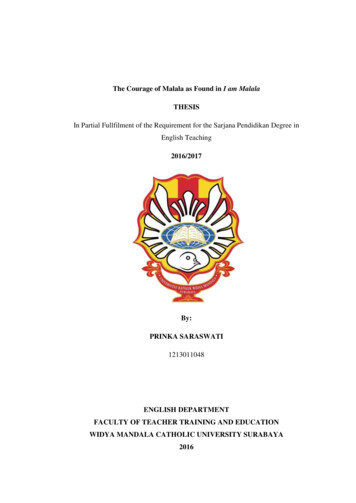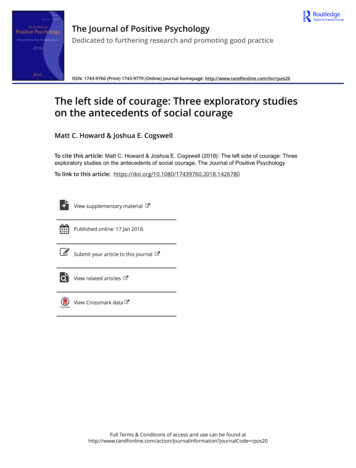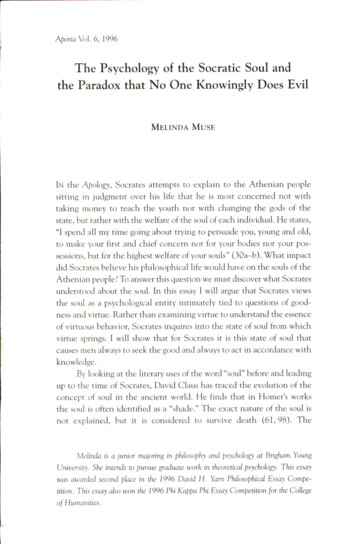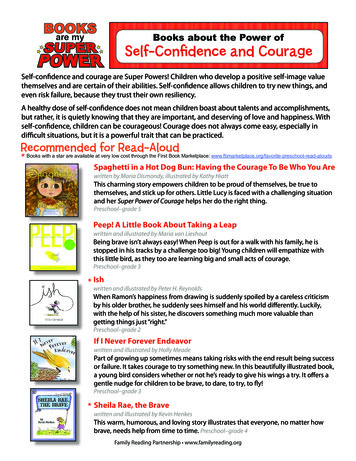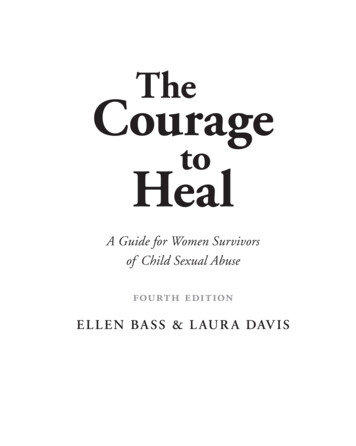
Transcription
TheCouragetoHealA Guide for Women Survivorsof Child Sexual Abusefourth editionE L L E N B A S S & L AU R A DAV IS
TABLE OF CONTENTSAbout the Authors1Also From Ellen Bass and Laura Davis2Major Changes to the Fourth Addition3Using the Writing Exercises4Writing Exercises7Supplementary Charts13Levels of Sexual Interaction15Resource Guide17Acknowledgements82List of Poems90Footnotes92
Ellen Bass is a pioneer in the field of healing for survivors of child sexual abuse. She co-edited INever Told Anyone: Writings by Women Survivors of Child Sexual Abuse (HarperCollins, 1983) and withco-author, Laura Davis, published The Courage to Heal: A Guide for Women Survivors of Child SexualAbuse (HarperCollins, 1988, 2008) and Beginning to Heal: A First Book for Men and Women Who WereSexually Abused As Children (HarperCollins, 1993, 2003). She is also co-author, with Kate Kaufman, ofFree Your Mind: The Book for Gay, Lesbian and Bisexual Youth and Their Allies (HarperCollins, 1996).Ellen Bass co-edited with Florence Howe the groundbreaking No More Masks! An Anthology of Poems byWomen (Doubleday, 1973) and has published several volumes of poetry, including Mules of Love (BOA,2002) and The Human Line (Copper Canyon Press, 2007). She has published poems in The New Yorker,The Atlantic, American Poetry Review and many other journals and has a new volume, Like a Beggar,forthcoming from Copper Canyon in 2014.She teaches in the MFA writing program at Pacific University and at conferences and workshops nationally and internationally.www.ellenbass.comLaura Davis is the author of seven non-fiction books, including The Courage to Heal, The Courageto Heal Workbook, Allies in Healing, Beginning to Heal, Becoming the Parent You Want to Be and I ThoughtWe’d Never Speak Again. Laura’s groundbreaking books have sold more than 1.8 million copies aroundthe world. Laura leads weekly writing groups and memoir writing retreats in the Santa Cruz, CA region,as well as an annual summer writing retreat in Bolinas, California, a two-week long writing and yogaretreat in Bali, and other international retreats. Laura also sends out a free weekly inspirational quoteand writing prompt, called the Writer’s Journey Roadmap each week, and readers can post their writtenresponses to the weekly prompts on her supportive, vibrant online community. To learn more aboutLaura, her books or her workshops, visit Laura’s ap1
A l s o f r o m E l l e n B a s s a n d La u r a Da v i sEllen BassLike a Beggar (poetry - forthcoming in 2014)The Human Line (poetry)Mules of Love (poetry)No More Masks! An Anthology of Poems by Women(coeditor, with Florence Howe)I Never Told Anyone:Writing by Women Survivors of Child Sexual Abuse(coeditor, with Louise Thornton)Free Your Mind:The Book for Gay, Lesbian, and Bisexual Youth—and Their Allies (with Kate Kaufman)I Like You to Make Jokes with Me, But I Don’t Want Youto Touch Me (for children)Laura DavisThe Courage to Heal Workbook:For Women and Men Survivors of Child Sexual AbuseAllies in Healing:When the Person You Love Was Sexually Abused as a ChildBecoming the Parent You Want to Be:a Sourcebook of Strategies for the First Five Years(with Janis Keyser)I Thought We’ d Never Speak Again:The Road from Estrangement to ReconciliationThe Last Frontier:Is Reconcilation Possible After Sexual Abuse?(available at www.lauradavis.net)Ellen Bass and Laura DavisBeginning to Heal:A First Book for Survivors of Child Sexual AbuseFor current listings of foreign-language editions of both The Courage to Heal andBeginning to Heal, please visit www.ellenbass.com/books/php.2
The major changes in this edition are: An emphasis on self-care and pacingso that you don’t become overwhelmed or retraumatizedduring the healing processAn increased focus on the body’s role in healingNew research on trauma and the brain, traumatic amnesia,memory, and post-traumatic stress disorder (PTSD)The inclusion of additional healing tools, including imagery, meditation, spirituality, and body-centered practicesNew stories that reflect an even greater diversity of survivors and their experiencesIn-depth guidance to help you assess how you want torelate to your family now and over timeNew prose writings and poetry (all of the prose pieces arefrom survivors of child sexual abuse; most of the poemsare written by survivors, as well, though some are not)The wisdom of survivors who have been healing fortwenty years or moreWe didn’t include “Honoring the Truth,”1 our 1994response to the backlash against survivors of child sexualabuse, to make room for new stories and informationabout healingA thoroughly updated Resource Guide, reflecting theabundant books, organizations, films, and online resources now available1 You can read “Honoring the Truth” online at the Sur vivors Healing Center Website: www.survivorshealingcenter.org/truth.3
Using the Writing Exercises“There is no agony like bearing an untold story inside you.”—Z o r a N e a l e H u r s t o nFor many years, Ellen led I Never ToldAnyone workshops for adult survivors ofchild sexual abuse. Women came together inan environment of support, confidentiality,and safety to explore their feelings, mourntheir violation, gather their strength, and celebrate their survival.In the workshops, women were asked towrite about being sexually abused as children.So often survivors have had their experiencesdenied, trivialized, or distorted. Writing is animportant avenue for healing because it givesyou the opportunity to tell your own story, torelate your history as you experienced it. Youcan say: This happened to me. It was that bad.It was the fault and responsibility of the adult.I was—and am—innocent.4By going back and writing about what happened, you also reexperience feelings and areable to grieve. You excavate the sites in whichyou’ve buried memory and pain, dread andfury. You relive your history, but this time withthe compassionate support of your adult self.Why Writing ?One handy thing about writing is that it’s almost always available. At three in the morning,when you’re alone or you don’t want to wakeyour partner, when your friend’s out of town,when your counselor’s answering machineis on and even the cat is out prowling, your
journal is there. It’s quiet, cheap, and portable.A journal can help you figure out how you feel,what you think, what you need, what you wantto say, how you want to handle a situation, justby writing it through.Anyone Can Use WritingUsing writing as a healing tool can be helpfulwhether or not you participate in an organizedworkshop with other people. You don’t needto think of yourself as a writer or even like towrite. You may have had a limited education.Perhaps you can’t spell or you think you’re aterrible writer.Some survivors have special blocks associated with writing. If your mother read yourprivate diary, if your father was an Englishteacher and always criticized your writtenwork, if your best friend passed your intimateletters around the junior high school cafeteria,you may be wary of putting words on paper.But all of us have a deep need for self-expression. Yours may take forms other than writing,but if you’d like to try writing as one methodof healing, even previous blocks need not standin the way. Many women who have been reluctant to write have done these exercises—andbenefited enormously.Time and Pl aceminutes of writing time for each exercise,though even ten minutes can produce deepand powerful results. Many survivors find ithelpful to decide on a fixed ending time beforethey begin; it creates a container that makes itsafer to write about their abuse.Some women like to start with a ritual—you might light a candle, meditate or say aprayer, make a cup of tea, or just take a moment to sit quietly—and also end with one.These clear markers on either side of your writing time create safety and can help you reenteryour daily life a little more easily.Since writing about sexual abuse oftenbrings up strong feelings, don’t squeeze inyour writing between picking the kids up fromschool and starting dinner. Make sure you giveyourself some time afterward to absorb the impact of the writing.If you feel shaken up by what you’ve written, you might want to finish your writing session with five or ten minutes of writing on atopic that reminds you of your resilience andstrength, such as, “The Ground On Which IStand” or “Things I’m Grateful For,” or “WhatGives Me Strength.” Other women have foundit useful to go on a short walk after writingor to do a grounding exercise to anchor themmore firmly in the present.If you feel overwhelmed by what you’vewritten or find yourself flooded with emotionsfrom the past, refer to “Calming Down” (p. 35)for suggestions for calming yourself down andregaining your equilibrium.Choose a time and place where you won’t beinterrupted. It’s good to have at least twenty5
Being HeardWriting itself is very helpful, but sharing whatyou’ve written is important, too. After youwrite, read your writing to someone who willlisten attentively and with compassion.If there’s no one you can read to right away,read out loud to yourself—at least you will bereading to one attentive listener. Just sayingthe words can make them more real. Oftenyou don’t feel the impact of what you’ve written until you speak the words out loud.If you read your writing to someone whohas no experience in listening to personal writing, tell that person what you need. You won’twant them to criticize or judge what you haveto say. You may want them to ask questions, tohelp you talk about it more, or to simply listenquietly. You may want comforting or you maynot. People usually respond in more satisfyingways when you tell them what you need.The Basic Me thodTry to forget everything you’ve ever been toldabout writing. What you’re going to do is akind of free writing, or stream-of-consciousnesswriting. It’s not about making art or getting agood grade or trying to make sense to someoneelse. Rather it’s a way to short-circuit your censors to get to what you need to say.Write without stopping. Go at a pace that’scomfortable for you, and don’t stop. If you getstuck or can’t think of anything to say, youcan write, “This is the stupidest exercise I ever6heard of,” or “I’m hungry—I wonder if time’sup yet.” One woman who was writing abouther abuse stopped every few lines and wrote, “Icannot say any more,” and then went on to saymore. Giving herself permission to stop madeit possible for her to continue telling her story.You needn’t use full sentences. You needn’tspell or punctuate properly. It can be in English or in another language. Sometimes if another language was spoken when you were achild, you will remember or write more fluidlyin that language. If you were abused beforeyou learned to talk, your writing may soundchildish or come out as baby talk.
Writing E xercise :The Effec tsWriting E xercise :I Remember, I Don’ tRememberFrom the chapter “Effects: Recognizingthe Damage”From the chapter “Remembering”Write about the ways you’re still affected bythe abuse. What are you still carrying in termsof your feelings of self-worth, your relationships, your sexuality, your work? How is yourlife still pained, still limited?Write about the strengths you’ve developed because of the abuse. Think of what it’staken for you to survive. What are the qualities that enabled you to make it? Perseverance?Flexibility? Self-sufficiency? Write about yourstrengths with pride.Write for ten minutes, beginning with thewords I remember. You can write about any aspect of your childhood. When you run out ofthings to write, start a new sentence with thewords I remember.Do the same thing, beginning with thewords I don’t remember. Continue for ten minutes without stopping, always coming back tothe starting phrase I don’t remember.Writing E xercise :The Fir st Silence YouBreak Is to Your selfWriting E xercise : CopingFrom the chapter “Coping: HonoringWhat You Did to Survive”From the chapter “Breaking Silence”You’ve read about different ways that peoplehave coped. Some of these you will identifywith. There may be others not mentioned thathave been recurring themes in your life. This isan opportunity for you to write about your experience of coping—how you’ve coped in thepast, how you’re coping today, and how thesechoices have affected your life. Write with asmuch detail as you can, always from the perspective of honoring what you did.7Many women have found it very difficult totell people that they were sexually abused.When they do tell, it is often in very generalized terms: “I was molested by my brother”;“I was raped when I was ten.” Rarely do theyshare the details, partly because it’s hard to telleven the general facts and partly because theywant to spare the listeners. They don’t wantto impose.But the tight statement “My stepfatherabused me” is not the way you live with theabuse or experience flashbacks. That’s not indicative of the creepy feelings you get whensomething triggers your memory. What you
remember are the details: the way the light fellon the stairway, the pajamas you were wearing,the smell of liquor on his breath, the feel of thegravel between your shoulder blades when youwere thrown down, the terrifying chuckle, thesound of the TV downstairs.Write about your experience of being sexually abused as a child. When you write, includeas many sensory details as you can—what youactually saw, heard, smelled, tasted, felt.If your abuse covers too much time and toomany abusers to write it all in half an hour, justwrite what you can. Don’t worry about whichexperience to start with. Begin with what feelsmost accessible or what you feel you most needto deal with. This is an exercise you can doover and over again.If you don’t remember a lot of the detailsof what happened to you, write about whatyou do remember. Re-create the context inwhich the abuse happened, even if you don’tremember the specifics of the abuse. Describewhere you lived as a child. What was going onin your family, in your neighborhood, in yourlife? Some women think they don’t remember,when actually they remember quite a lot. Butsince the picture isn’t in sequence and isn’t totally filled in, they don’t feel they have permission to call what they know “remembering.”Start with what you have. When you use thatfully, you may find that you get more.If there’s something you feel that you absolutely can’t write, then at least write that there’ssomething you can’t or won’t write. That wayyou leave a marker for yourself; you acknowledge that there’s a difficult place.If you go off on tangents, don’t pull yourselfback too abruptly. Sometimes what may look8irrelevant leads us to something more essential.Although you want to stay with the subject, doso with loose reins.There is no one right way to do this exercise. Your writing may be linear, telling yourstory in chronological order. It may be a washof feelings and sensations. Or it may be like apatchwork, piecing together scattered bits andpieces. As with all the writing exercises, try notto judge or censor. Don’t feel that you shouldconform to any standard, and don’t compareyour writing with others. This is an opportunity to uncover and heal, not to perform orto meet anyone’s expectations—not even yourown.Writing E xercise :The Child WithinFrom the chapter “The Child Within”This is a chance to talk to the child within.If you’re capable of loving and comforting thechild within, express the compassion that youfeel toward her. You can do this by writing aletter directly to her. Or you can engage in awritten dialogue, first writing as the adult andthen as the child responding. You may find ithelpful to place a childhood photo of yourselfin front of you as you write.If you don’t yet feel any connection, allegiance, or tenderness toward the child yet, startwith how you honestly feel. You can’t write,“I love you, I’ll take care of you,” if that’s alie. Start with: “I’m willing to sit down andwrite to you even though I’m not quite sureyou exist” or “I don’t know how to love you.”
Any point of contact is a start. You can’t have aloving relationship until you take the first step.Another way to get in touch with yourinner child is to write a dialogue using yourdominant hand (your right hand if you’reright-handed; your left if you’re left-handed)for your adult self and your other hand for thechild’s responses. Writing with the nondominant hand is slow and childlike and can helpevoke the feelings and voice of the child.With your dominant hand and in your ownadult voice, ask the child a question, such as“What do you need right now?” or “How canI take care of you?” Or “Can you tell me a littleabout yourself?” Then, switching your pen (orcrayon or marker) to the other hand, respondin the voice of the child. When it feels like thechild has had her say, switch back to the otherhand and respond as your adult self. Go backand forth, changing hands, until you feel finished. This can be an effective way to open upa dialogue with your inner child.If you feel totally alienated from the childwithin, imagine another child the age you wereduring your abuse. Try writing to her instead.This is a good exercise to do more thanonce, particularly if you’re not starting from aplace of compassion. Eventually you’ll be ableto tell the child that she’s not to blame, thatshe’s innocent, and that you’ll protect her.9Writing E xercise :GrievingFrom the chapter “Grieving”Write about what you’ve lost, what was taken,what was destroyed. Write about the extent ofthe damage. Write about the things you needto grieve for. This is a chance to give voice toyour pain, and to write about how you feelabout your loss.Writing E xercise : AngerFrom the chapter “Anger”Write a letter to your abuser. Do not be reasonable. This is not a letter to send. Write exactly what you want to say without thinkingabout possible repercussions. Be as blunt andhurt and angry as you want to be. Express yourlonging. Express your grief. Express your rage,your hurt, your humanity. Say it all. Let it bea cleansing.You can write this letter more than once.You might have had more than one abuser.Your feelings about your abuser may changeover time. You may want to write to a nonprotective parent or other person as well.
fulfilling life. This “Letter of Thanks to Myself” is apowerful writing exercise that can highlight all thatyou’ve accomplished on your healing journey.1Writing E xercise :Changing Pat ternsFrom the chapter “The Process ofChange”Dear Cassondra,Take some time to assess how far you’ve comein your healing. Are you at the beginning, orhave you made some progress? What have youaccomplished already? What do you have tobe proud of? What obstacles have you brokenthrough? What small (and large) successeshave you achieved? Even just making the decision to heal is a major step. Give yourselfcredit. In detail.You’ve already done a lot of work—andthere’s still more to do. What are your goalsfor your healing now? What are some waysyou may be able to work toward these goals?Write about the things you still need to do tomove ahead in your personal life. These canbe general, such as “I need to be more compassionate with myself,” or as specific as “I need togo back to school so that I can do work that’smeaningful to me.”When you tried to kill yourself at 13 because ofthe pain, but couldn’t, you then made a pactwith yourself to find a better life when you grewup and were finally able to leave the madhouseyou called “home.”Thank you, thank you for having the courage toopen your eyes wide and not live in denial. Youwere sexually abused, but because you workedhard, now we have a good life. Because youfelt all the pain, got therapy, went to 12-step,did your journaling, called someone whenyou needed support, we are alive and livinglarge. Because we got help, we are not nearlyas afraid of new people and experiences. Wecan travel. We can have a good (really good)sexuality. We don’t hurt ourselves anymore.We don’t overdo with alcohol or sugar. We canhave an intimate relationship, and best of all,we can feel.There is no empty hole. There is no morelosing time. Feelings the feelings may be tough,but even the hard feelings are better than theemptiness used to be.Writing E xercise :What I’m Grateful For:A Letter of Thanks toMyselfFrom the chapter “Self-Esteem andTrusting Yourself”Cassondra Espinoza wrote this letter to herself asan exercise in her Latina survivors’ group. In it, shethanks herself for her dedication to healing and everything she has done to be able to have a functional,10Thank you for learning to take care of our body,for not being afraid to look good. Thank you forlearning how to figure out when something (asituation) or someone is bad for us. Thank youfor learning about boundaries and being able tosay NO!Thank you for knowing that feelings aren’tgoing to kill you, that they will change, lessen,
and there are do-overs. It’s okay to makemistakes and say you’re sorry when necessary,especially to yourself.the sentence: “ feels like this,” fillingin the blank with the emotion you have chosen.Then, using the guidelines for free writing on pagexxix, write for ten minutes without stopping aboutthat feeling or state of mind. Whenever you runout of things to say, return to the original phrase,“Shame feels like this . . .” or “Gratitude feels likethis . . .” or “Betrayal feels like this. . . .”A sample response might start like this:Thank you for learning how to be a good mom.Thank you for struggling through the hardtimes and not giving up. Thank you for keepinga positive outlook on life and learning howto start trusting people, relationships, and ahigher power.Fear feels like this: a giant vice, slowly, inexorably closing in on my chest. It is gettingWriting E xercise :harder and harder to breathe, but there isWrite About Your Feelingsno way for me to stop the pressure. FearFrom the chapter “Getting in TouchWith Your Feelings”stopping outside my door on a stiflingfeels like this: the sound of heavy footstepssummer night. I know the door will openBuddhist teacher Ajahn Sumedho2 talks aboutsoon. Fear feels like this: standing in frontof the class with everyone staring at me. Ilearning to become a witness to your own feelknow I am there for a reason, but my mindings. Rather than saying, “I’m angry,” he sugis blank and I have nothing to say. Fear feelsgests saying, “Anger feels like this. . . .” Insteadlike this: I am sitting at the kitchen tableof saying, “I’m happy,” try saying instead, “Hapfolding yellow towels. The light changes andpiness feels like this. . . .” Instead of saying, “II am transported back to another kitchenfeel ashamed,” try, “Shame feels like this. . . .”from long ago. I hear my mother’s voice onWitnessing your feelings in this way can bethe front stoop. I know instantly that shehelpful if you find yourself frequently beset by ais loud, sloppy, and drunk. I should callparticular emotion and want to understand thesomeone to come and help me, but thererole it plays in your life. And if you find it difis no one to call, and besides, what wouldficult to identify or differentiate between feelI say? As I hear the key in the lock, I shrinkings, this exercise can be a way to explore theback into my body and go very far away.nature of the feeling itself.Fear feels like this: . . .”Go back to the list of words in the “What AreFeelings?” exercise on page 228. Identify the emotions that you frequently experience. If there areContinue writing until the ten minutes are up.other feelings that you feel regularly, add them to Afterward, it’s helpful to read what you’ve writthe list. Now choose one that you are willing to ten aloud to yourself or to a supportive person.explore. Then, at the top of a sheet of paper, write Then try doing the exercise again using a different emotion.2 Ajahn Sumedho teaches in the Theravadin Thai Foresttradition of Buddhism.11
Writing E xercise :Your Family NowFrom the chapter “Relating to YourFamily Now—and Over Time”What are the positive aspects of relating toyour family of origin now? What do youlike? Who are your supporters? Whom doyou enjoy being with? What is nurturing orsatisfying for you in your contact with them?What isn’t okay for you? What is destructive, irritating, infuriating, frightening, threatening, painful? Whom do you feel bad beingwith? What are the disadvantages of beingwith your family?12
Supplementary ChartsMost of the exercises and concepts in The Courage to Heal audio edition are clear without any graphicpresentation, but the following two sections are helpful to see, so we’ve included them in thissupplementary material. The first, “Exercises for Getting in Touch with Your Feelings” is one of theexercises in the chapter “Getting in Touch With Your Feelings” and the second is “Levels of SexualInteraction” from the chapter “Reclaiming Your Sexuality.”13
Exercises for Getting inTouch With Your Feelingsyou are finished, choose the three words that yourespond to most strongly.The next two exercises, from Learning to LiveWithout Violence by Daniel Sonkin and MichaelDurphy, can be helpful in beginning to identifyfeelings.1Feeling vs. Thinking eople commonly confuse feelings with thinkPing or observation. For example:“I feel it was unfair.”“I feel you are going to leave me.”These statements are “I feel-thinking”statements rather than “I feel-emotion” statements. A good test for whether a statementis an “I feel-thinking” statement is to replace“I feel” with “I think.” If it makes sense, thenit is probably more of a thinking statement orobservation than a feeling statement. If wechange the above “I feel-thinking” statementsto “I feel-emotion” statements, they ressedfrightened vedangryUse Your MindIf you can’t readily identify a feeling, your intellect can sometimes help. Say to yourself,“My lover just left me and I don’t feel anything. What would someone else be feelingin this situation? What have I learned frombooks, movies, and friends about the feelingsthat might be common in this circumstance?Could it be relief? Anger? Grief? Could that bewhat this knot in my throat is about?”Draw Your Feelings“I feel hurt by what you did.”“I feel afraid that you might leave me.”Amy Pine, a creative-arts therapist in SantaCruz, California, suggests trying to draw afeeling that you have. Use color, shape, texture, degree of pressure, space, and literalpictures to help you express this feeling. Stickfigures are also fine. Then draw the way youwant to feel. Share these drawings with someone. What do they represent? What do younotice when you look at them? Then draw athird picture that takes elements of the firstthrough a transition that brings it to the second. What had to happen to connect them?How did you do it? Is there any correlationwith what you might do in your life?What Are Feelings?Here is a list of feeling words. Say them out loud.Try out different tones of voice for each word,or say it louder or softer. Pay attention to yourfeelings as you say each word. What sensationsdoes it stir up? How does your body feel? Dosome words fit you, but not others? Add anyother words that especially describe you. When1 Daniel Jay Sonkin and Michael Durphy, Learning to LiveWithout Violence, updated edition (Volcano, CA: VolcanoPress, 1997).14
Graphic from The Courage To HealThe Hierarchy of Sexual InteractionLevels of Sexual Interactionof sexual interaction—whether it is experienced as healthy or hurtful. Conditions suchas consent, equality, respect, trust, and safetylead to healthy interactions, while dishonesty,disregard for physical safety, domination, objectification, and shame lead to negative interactions.Within this model, we don’t judge specific sexual behaviors. Instead, we look atthe context in which a sexual behavior takesplace—and the consequences of that behavior.Sexual energy can unite a c ouple in a danceof tenderness and passion, heightening theirself- awareness and strengthening their connection and commitment to each other. Or, ifused in a violent act such as rape or humiliation, sexual energy can shatter trust and destroy one’s sense of self-worth and safety. Andof course there is a great range in betweenthese extremes.Wendy Maltz, therapist and author of thegroundbreaking book The Sexual Healing Journey,* has created a Hierarchy of Sexual Interaction that provides a useful way of evaluatingsexual behavior within the context of relationships. Sexual energy is recognized as a naturalforce that can be channeled in either destructive or life-affirming ways. Maltz’s modelpresents six levels of sexual interaction: threenegative levels (impersonal, abusive, and violent) and three positive levels (role fulfillment,making love, and authentic sexual intimacy).This way of looking at sex makes clear theneed for communication, safety, and trustand points to authentic sexual intimacy as apeak experience in human relationships.Certain conditions determine the nature* Wendy Maltz, The Sexual Healing Journey: A Guide forSurvivors of Sexual Abuse, revised edition (New York: Quill,2001). There is also a wealth of information on WendyMaltz’s Web site at www.healthysex.com.15
POSITIVE AND NEGATIVEDIRECTIONS IN THEMALTZ HIERARCHYOF SEXUALINTERACTIONPOSITIVE DIRECTIONlife-affirming celebrationhealthy bondingconnectednessSexual energy is a benign, naturalcreative expressionforce which can be channeled inemotional intimacyeither positive or negative directions.enhanced self-esteemBelow are two different sets ofopen communicationqualities each corresponding with amutual respectdifferent direction. The negativetrustqualities increase and intensify assense of equalityone travels downward, and positivequalities increase and intensify asconsentone travels upwa
Jun 24, 2020




